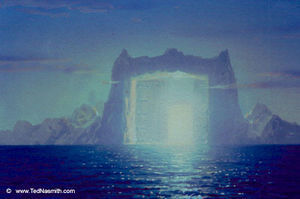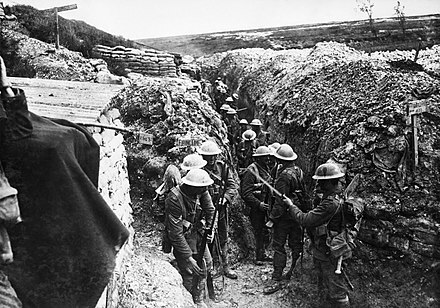Blind Read Through: J.R.R. Tolkien; The Book of Lost Tales, part 1; The Hiding of Valinor, part 2
 Art by Ted Nasmith
Art by Ted Nasmith“Thereat did Tulkas laugh, saying that naught might come now to Valinor save only by the topmost airs, ‘and Melko hath no power there; neither have ye, O little ones of the Earth’. Nonetheless at Aulë’s bidding he fared with that Vala to the bitter places of the sorrow of the Gnomes, and Aulë with the mighty hammer of his forge smote that wall of jagged ice, and when it was cloven even to the chill waters Tulkas rent it asunder with his great hands and the seas roared in between, and the land of the Gods was sundered utterly from the realms of the Earth (pg 210).”
Welcome back to another Blind Read! This week we conclude the tale of The Hiding of Valinor, as Tolkien delves deep into how he wanted to create the world.
This week is a perfect example of what a plotter writer does to create their world. Speaking from my own experience, worldbuilding is one of the hardest things to do as a writer because you want to thread the needle between creating a full, lush, believable world and muddling that same world with incessant useless details.

The Book of Lost Tales was never an actual book but a collection of notebooks, poems, anecdotes, and loose scrap paper Tolkien used to create his world over decades. From The Great War’s trenches to The Hobbit’s eventual publication, he filtered these notes to make what would later become The Silmarillion.
The Book of Lost Tales holds all the different cockamamie concepts which could comprise a fairy world. Christopher tells us many times that some of the detail has been cut because the text was re-written so many times (potentially multiple times in pencil and erased until Tolkien had a version he liked enough to write it out in pen… which many times was still not the last iteration)
What I’d like to cover this week for some fun differences is the detail Tolkien went to explain how the world came into being, which he later cut because much of it has little or nothing to do with the actual world.
The first instance I’d like to cover is the minutia of the Sun and the Moon route.
The Valar have a council for multiple pages concerning how they would go about hiding Valinor: “Nonetheless Manwë ventured to speak once more to the Valar, albeit he uttered no word of Men, and he reminded them that in their labours for the concealment of their land they had let slip from thought the waywardness of the Sun and the Moon (pg 214).”
We’ve previously discussed the path the Sun and the Moon had taken because of where different Valar (and Ungoliant) took up their residence. Still, they worry about “removing those piercing beams more far, that all those hills and regions of their abode be not too bringht illumined, and that none might ever again espy them afar off (pg 214).”
Yavanna worried that the change in the movement of the light from either the Sun or the Moon could create strife in the world, so Ulmo told them they had nothing to worry about. The Ocean is so large that the Valar don’t even fully comprehend its magnitude, nor have they ever interacted with any of the creatures of the world, “but Vai runneth from the Wall of Things unto the Wall of Things withersoever you may fare…ye know not all wonders, and many secret things are there beneath the Earth’s dark keel, even where I have my mighty halls of Ulmonan, that ye have never dreamed on (pg 214).”

Ulmo tells the other Valar they have nothing to worry about because the world is so vast that Ilúvatar’s children could never find them after centuries of looking. To counteract that worry, Ulmo and Aulë say they will build ships that can sail into Valinor so that Men and Eldar can come home.
The way Tolkien writes it, it’s unclear whether he means for the “children” to come home to heaven, or something a little more fairy tale-esque, like the Elysian Fields of Greek Mythology fame or Valhalla of the Norse. In any case, it’s a clunky bit of logic. I find it fascinating to see how Tolkien began devising the world, but I agree with Christopher that this level of detail is unnecessary for the greater story.
Finally, I’d be remiss if I didn’t mention one more cut—the creation of time.
“‘Lo, Danuin, Ranuin, and Fanuin are we called, and I am Ranuin, and Danuin has spoken.’ Then said Fanuin: ‘And we will offer thee our skill in your perplexity – yet who we are and whence we come or whither we go that we will tell to you only if ye accept our rede and after we have wrought as we desire (pg 217).'”
Instead of having time be attributed to the movement of the Sun and the Moon, Tolkien went much more mythological and created Tom Bombadil-type characters to create a way to understand the passing of time.
Danuin is the anthropomorphized concept of a Day, Ranuin is Month, and Fanuin is Year. They appear out of nowhere and approach the gods, offering gifts that later become this understanding of the passing of time.

Tolkien tells this tale at the end of the Hiding of Valinor because it is meant to be a passage of responsibility of the world to the next generation, the Eldar. The Valar are hiding away in Valinor, and the coming of these brothers created the concept of an “age.”
Before this moment, time didn’t exist, so the Valar just went about doing what they thought necessary, but this is also why the Eldar are immortal as well because they were born before time existed, men were born just after, so they were beholden to its aspect:
“Then were all the Gods afraid, seeing what was come, and knowing that hereafter even they should in counted time be subject to slow eld and their bright days to waning, until Ilúvatar at the Great End calls them back (pg 219).”
The brothers bestow this curse (or gift) of time and then say, “our job is done!” and peace out.
It’s curious how the brothers came into being, seeing as the Valar created everything in the world, but then again, there are deeper and unknown places in the world that others don’t know about, so this is a slight possibility; it’s just a clunky and unnecessary addition and one that even Christopher is glad he eventually cut:
“The conclusion of Vairë’s tale, ‘The Weaving of Days, Months, and Years’, shows (as it seems to me) my father exploring a mode of mythical imagining that was for him a dead end. In its formal and explicit symbolism it stands quite apart from the general direction of his thought, and he excised it without a trace (pg 227).”
Even Tolkien creates things where he looks back at it and realizes how out of sorts they are. Stand proud when you find mistakes because you know you FOUND them!
Join me next week as we jump into the last chapter of The Book of Lost Tales, part 1, “Gilfanon’s Tale: The Travail of the Noldoli and the Coming of Mankind.”



